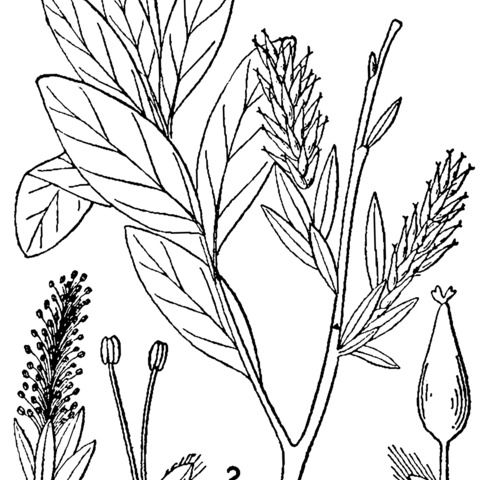Plants 0.2-1.5 m, forming clones by layering. Stems erect, decumbent or trailing; branches gray-brown, glabrous; branchlets yellow-brown or red-yellow, glabrous or puberulent (hairs straight, minute, inner membranaceous bud-scale layer free, not separating from outer layer). Leaves: stipules absent or rudimentary; petiole (deeply to shallowly grooved adaxially), 3-8 mm, (glabrous or puberulent); largest medial blade narrowly oblong, oblong, narrowly to broadly elliptic, narrowly oblanceolate or oblanceolate, 19-53(-69) × 5-20 mm, 1.8-4.9 times as long as wide, base convex or rounded, margins flat or slightly revolute, entire, apex acute, convex, or rounded, abaxial surface glabrous, adaxial dull, glaucous, glabrous (rarely very sparsely short-silky, hairs usually white, sometimes also ferruginous); proximal blade margins entire; juvenile blade (reddish or yellowish green), glabrous, puberulent, or sparsely pubescent abaxially, (hairs usually white, sometimes also ferruginous). Catkins: staminate 11-21 × 4-8 mm, flowering branchlet 3-12 mm; pistillate loosely flowered, stout or subglobose, 14-37 × 5-14 mm, flowering branchlet 7-25 mm; floral bract tawny or light rose, 0.8-1.6 mm, apex rounded, entire, abaxially very sparsely hairy distally, hairs straight or wavy. Staminate flowers: abaxial nectary absent, adaxial nectary oblong or narrowly oblong, 0.5-1.1 mm; filaments distinct or connate less than 1/2 their lengths, glabrous, or hairy basally or on proximal 1/2; anthers (yellow), ellipsoid, 0.4-0.6 mm. Pistillate flowers: abaxial nectary absent, adaxial nectary oblong, 0.2-1.4 mm, shorter than stipe; stipe 2.1-3.2 mm; ovary obclavate, often glaucous, glabrous, beak abruptly tapering to styles; ovules 4-6 per ovary; styles connate or distinct 1/2 their lengths, 0.1-0.2 mm; stigmas flat, abaxially non-papillate with rounded tip, or 2 plump lobes, 0.2-0.25-0.36 mm. Capsules 4-8 mm. 2n = 38, 57, 76.
More
Slender, sparingly branched shrub (2–)4–10(–15) dm, with dark, glabrous twigs; stipules none; petioles short, mostly 2–7 mm; lf-blades at first silky, but very soon glabrous, entire, narrowly or broadly elliptic to oblanceolate or obovate, (2–)3.5–6(–8) × 0.5–2(–3) cm, entire, often slightly revolute, green above, commonly glabrous and glaucous beneath, finely raised-reticulate on both sides, with parallel primary lateral veins; catkins with the lvs, 1–3 cm, on leafy peduncles 2–4(–5) cm; scales 1 mm, yellowish-brown, hairy within, at least near the tip, the hairs surpassing the scale, otherwise generally glabrous; stamens 2; frs narrowly lanceolate, 4–7 mm; pedicels 2–3 mm; style 0.1–0.3 mm; 2n=38, 57, 76. Sphagnum-bogs and swamps; Nf. to Yukon and B.C., s. to N.Y., N.J., n. Io., and Oreg.


